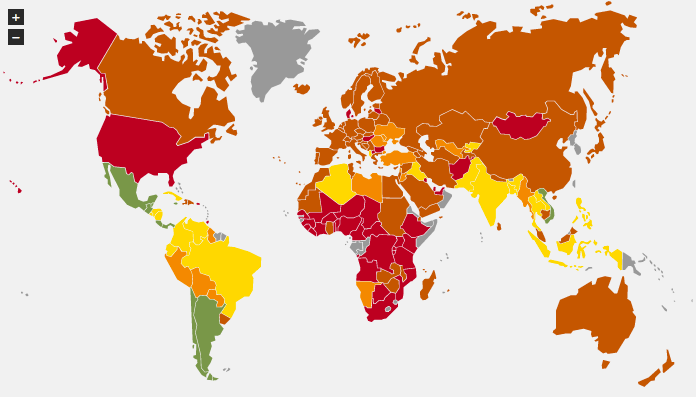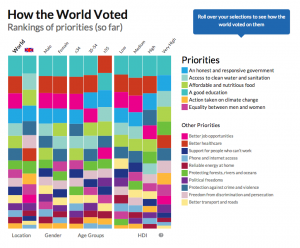The subject of the seventh and final taught week of the emerging trends in global health course focused on the concept of sustainable development and the environment and how these relate to health.
A widely recognised definition of sustainable development is provided by the United Nations:
“Sustainable development is development that meets the needs of the present without compromising the ability of future generations to meet their own needs”
United Nations 1987
There are three key pillars to sustainable development:
- economic development,
- social equity
- and environmental protection.
and health is involved in all three of these.
Climate change and the negative impact of our activities on our environment continue to be controversial issues despite widespread recognition that the quality and functioning of our environment are key determinants of our health. McMichael (2009) argues that the health of the population is the real “bottom line” indicator of environmental and social conditions and he suggests that “environmental sustainability” must be ultimately about sustaining health.
Climate change has the potential to negatively impact upon health and reduce living standards around the world, through changing weather patterns affecting access to water and agriculture and changes to regions affected by diseases. Many countries of the world lack the wealth, adequate technology and government institutions to deal with climate change, exacerbating inequities in health between poor and rich areas of the world. This reflects what is sometimes referred to as ‘environmental injustice’. Costello et al (2009)
The concept of ecosystem services was introduced which attempts to highlight how our natural environment functions to provide us with many of the basic necessities we need to live. For example clean water is originally provided by rainfall collected in a watershed and filtered through plants, soils and rocks. This concept aims to engage the business and government communities in appreciating these vital roles when taking development decisions.
Measuring sustainable development
The commonly used measures of development and progress focus solely on the economic pillar of sustainable development ignoring the other two pillars. So it is not surprising that the levels and changes in these economic measures do not correspond to levels or changes in population health.
“Traditionally, it was thought that economic development (wealth, as measured by Gross Domestic Product) would automatically lead to health” however comparisons between countries such as the US and Costa Rica indicates that higher GDP does not on its own result in greater life expectancy. In this case US GDP is 4 times that of Costa Rica but average life expectancy is still one year less (Alsan et al., 2006).
An example of an attempt to provide a more holistic measure of development that also encompasses health and wellbeing is the Happy Planet Index. This uses three measures (life expectancy, experienced well-being and Ecological Footprint) to determine a score for each country that indicates “the extent to which countries deliver long, happy, sustainable lives for the people that live in them “. The map below shows the HPI resulting scores for the countries of the world where Green indicates a good score and red a poor score.
The food system
Obesity is now recognised as a global problem with enormous health implications. Current data suggests that in 19 out of the 34 OECD countries more than 50% of the population is over weight. While food selection and diet are considered an individual’s choice, the food systems that provide the options from which we can choose affect to a large degree the choices that individuals end up making. For instance subsidies that promote the growth of particular crops (e.g. corn) result in some ingredients being artificially low in cost (e.g. high fructose corn syrup). Inevitably these ingredients are then widely utilised in the production of the cheapest processed foods available. One course presenter, Prof. Schuter argued passionately that the world’s food systems need to be radically re-engineered and these subsidies be refocused to promote healthy food types over the unhealthy ones.
The secondary affects of the adoption of healthier diets also has implications for social equality (e.g. local food sourcing supporting small farmers) and the environment (e.g. reductions in livestock reducing green house gas emissions). The links between health related decisions and positive environmental implications go beyond the food system Kickbusch et al. (2010, p. 7) summarises this by arguing that
“in many cases, the best choices for health are also the best choices for the planet; and the most ethical and environmental choices are also good for health”.
Post 2015 Millenium Development Goals
The 8 Millenium Development Goals (MDGs) have been the focus of global efforts to achieve sustainable development since their agreement in 2000. For each goal a set of targets were defined to be achieved by 2015, but as you would anticipate despite much progress not all of these will not all be met. Haines et al. (2012) suggest this failure is due to a lack of integration between the efforts focused on separate social (including health), economic, and environmental priorities.
With 2 years remaining for the MDGs there is now a programme to determine a new set of Sustainable Development Goals (SDGs) to set the new development agenda. Contrary to the MDGs, which mainly focus on poor and emerging nations, it is anticipated that the SDGs will encompass both developed and developing countries. It is important that health issues are recognised in these new goals and the momentum achieved in the health related MDGs is not lost after 2015 (WHO task team 2013).
The United Nations has established top down and bottom up processes to gather opinions to influence the SDGs. The bottom up channel is an open consultation mechanism delivered by the My World and World We Want websites which can be used by anyone to add their perspective.
Implications for Physical Therapy / Physiotherapy
Sustainable development is a worthy and important objective and we must consider the ability of future generations to meet their needs in the decisions we take daily. These decisions may be work related such as where to source our healthcare products, what form of transport we use to commute to work and personal such as what food we choose to eat each day.
It is apparent to us through our work with patients that wealth does not equate to health and many of the global health problems of the future will affect all nations. The identification in the Happy Planet Index of the importance of the “experience of well being” is very relevant to our profession as this one of our primary contributions to the health and quality of life of our patients.
The opportunity to participate in the definition of the Sustainable Development Goals (SDGs) must be grasped by our profession to ensure our perspective is heard. We can do this individually through the My World (a simple poll that takes 1-2 minutes) and the World We Want web sites and we can encourage our professional organisations to represent our perspectives. It will be another 15 years before this opportunity arises again!

